Planning December 2018
The Scales of Gentrification
Cities strive to find the balance point between revitalization and gentrification.
By Pete Saunders
An interesting image has been making the rounds on my corner of social media lately. It's a humorous, half-serious attempt to establish a series of threat levels for neighborhoods in the path of that loathed phenomenon — gentrification.
Threat levels range from low ("Post-white flight urban areas" with "minority families chillin' in the neighborhoods they were redlined into decades ago") to severe ("Rents rise seasonally, artists can no longer afford to live there, and immigrant/minority families have long since been displaced to a neighborhood white people don't feel safe in"). The graphic's intermediate levels document other parts of the shift, from its loss of independent businesses, newcomer and long-timer conflicts, and racial and ethnic change.
Funny? Sure. True? Possibly. But more to the point, the graphic also embodies the mood and moment in many cities nationwide — the fear of community loss on one side and the anxiety stemming from being a catalyst to sweeping change on the other.
Gentrification. The term provokes all kinds of reactions and responses. For some it's a positive force as cities regain equilibrium with their surrounding metro areas. For others it's a scourge — the destabilizing first step that leads to the loss of affordable housing, and ultimately to low-income and minority resident displacement in city neighborhoods.
It means as many different things as there are cities dealing with its impact. But are cities effectively dealing with its impact, either positive or negative?
Can urban revitalization happen without gentrification?
A recent article in Smart Cities Dive, an online outlet of smart cities news, suggests that the Washington, D. C., experience means no. From the article:
According to Charles Hostovsky, a professor of urban planning at Catholic University in Washington, D.C., the speed of revitalization in D.C. has been extraordinarily rapid. Every neighborhood has cranes, signifying new development.
There has been a corresponding shift in the demographics of the city. In 1970, the city was 77 percent African American. Today, it's just 49 percent African American. "The number of people who have been displaced equals a small town." Indeed: in the past decade, approximately, 50,000 young, white millennials have moved into the city while 35,000 African Americans have left.
However, the same article references Hazel Edwards, FAICP, also a professor of planning at Catholic University, pointing out the experience of Melrose Commons in the South Bronx. There, a group of residents banded together to form an organization called Nos Quedamos (We Stay) to fight back against a New York City urban renewal plan in the early 1990s. Nos Quedamos brought in their own architect to create an urban design plan for their neighborhood, which resulted in 2,000 units of affordable housing.
In the article, Edwards goes on to say that revitalization without gentrification is "bringing residents and the community to the table often and at the beginning." How does that happen? Edwards says "cities have to form diverse, inclusive partnerships, foster openness, and collaborate on goals and outcomes."
In other words, it's not organic or intuitive; it requires mindful work.

Activists block Chicago's The 606 trail in 2016 to protest gentrification and displacement. Photo by Tyler Lariviere.
Finding the right balance
Here's what most people agree on regarding gentrification: It's some combination of rising home values and rents, rising income levels, and rising educational attainment levels, usually in longtime urban neighborhoods that historically had low levels in each. What most people react to are what results from that influx — new, often upscale, housing development; new commercial development that caters to an emerging clientele; and the change — or outright loss — of community identity.
People also react to investments, public and private, that act as a catalyst for such change. Parks, urban trails, public transit, even bike lanes are all things that make cities livable places but are eyed warily by those who view them as tools of displacement.
The anti-gentrification sentiment and the desire to create communities for those on all parts of the economic and social spectrum has been motivating planners and policy makers to try to find the sweet spot of fostering revitalization without gentrification, however defined.
Without question most American cities went through a long period where wealth virtually disappeared within their boundaries, and today they're reclaiming much of what had been lost. But how can cities do that without spurring economic and social inequality, and the resulting displacement?
Here are some examples of ways cities are approaching the challenge of revitalization without gentrification, and the types of tools they're using.

Map courtesy Data Driven Detroit.
INFORMATION
Data Driven Detroit's neighborhood change report seeks to monitor development activity in neighborhoods across the city, and develop an "early warning system" that alerts policy makers and residents alike of changes within their midst.
The report, called Turning the Corner (bit.Ly/2yEfyRy), takes both a qualitative and quantitative research approach to changes within a group of focus neighborhoods in Detroit.
The qualitative research includes interviews and focus groups with local residents, ranging in age from preteens to the early 70s. In the focus neighborhoods, researchers sought to get accurate demographic representation to answer questions — largely African American on the city's North End, for example, and primarily Latino from Southwest Detroit. Quantitative data, such as building permits, tax foreclosures, vacant and abandoned properties, water shut-offs, home sales, and crime data were noted.
The results of the interviews and focus groups were matched with the quantitative analysis to give researchers a baseline for the respective focus neighborhoods.
The researchers then conducted a factor analysis on the data. On the qualitative side, residents were especially sensitive to early indicators that they directly witnessed, such as streetlight replacement, street resurfacing, or increased police presence, giving them the sense that their neighborhood was being "prepped" for higher-income residents.
On the quantitative side, the researchers developed a set of indices for each qualifying block in the city, looking at factors like housing stability, crime, social advantage, business, and protective activities. Taken together, the qualitative and quantitative data give planners and policy makers in Detroit a thorough understanding of baseline neighborhood conditions within the focus neighborhoods and set the stage for evaluating neighborhood change at the block level in Detroit.
EQUITY
The Philadelphia Redevelopment Authority has included a social impact scoring element into requests for proposals that they issue for development. In them they encourage developers to seek out social impacts and to explain the social impact of their projects.
The prompts are intentionally open-ended, but they ask developers to use a quantitative approach and be specific in terms of the social impact they are proposing. They also ask developers to strongly consider possible ramifications resulting from development — a huge step forward in creating space in cities for all.
In 2016, PRA required responding developers to include a social impact component for an 80,000-square-foot, publicly owned lot at 8th Street and Vine in Philadelphia's Center City.
In an interview with Philadelphia Magazine at the time of the RFP announcement, PRA director Greg Heller said, "It was a good project to roll this out because it is in Center City, in a strong real estate market. And so we felt there was a lot more possibility for developers to use innovation and incorporate uses with a strong social impact — more so than in a weaker real estate market."
Two years in, the effort is working. Heller describes the outcomes so far: "We were able to get the developer to include independent, community-supported retail at the 8th and Vine location, as well as a public interest law center (nonprofit legal services). For a project in West Philadelphia, in a 'food desert,' we were able to develop an urban-style grocery and add 35 units of affordable housing to the community."
Heller notes that developers like the PRA's effort to address social impact. "Developers appreciate it. It gives them more opportunity to build distinctive and creative projects," he says.
INFRASTRUCTURE
In Atlanta and Chicago, recent infrastructure projects have acted as catalysts for dynamic neighborhood change, and planners in both cities are responding with programs designed to mitigate the impact.
Atlanta's BeltLine, a 33-mile-long trail system looping around Atlanta that creates or restores more than 2,000 acres of greenspace and serves as the setting for much of Atlanta's future public transit vision, has seen tremendous residential and commercial investment since its inception.
Unfortunately, the BeltLine has also fueled concerns about the loss of affordable housing, even prompting BeltLine founder Ryan Gravel to resign from the organization raising money for the project.
Since then Atlanta BeltLine, Inc. has redoubled its efforts to create 5,600 affordable housing units in areas adjacent to the trail network. To date, $12.5 million has been dedicated to affordable housing, via the Atlanta BeltLine Affordable Housing Trust Fund. The fund will assist home buyers with down payment assistance, land acquisition for future affordable housing, and for developer incentives for affordable housing development.
In Chicago, The 606, a 2.7-mile-long elevated trail on a former abandoned rail line, has been a well-received recreational resource in a dense and diverse part of the city. However, it's been blamed for providing a link between gentrified areas of Chicago with those that had largely escaped such activity, prompting displacement concerns.
As a result, Mayor Rahm Emanuel, in conjunction with Alderman Roberto Maldonado and Alderman Joe Moreno, announced that the city would create the 606 Bloomingdale Trail Neighborhood Home Improvement Program. It's a two-year pilot program, using $1 million from the city's Affordable Housing Opportunity Fund, administered by Neighborhood Housing Services of Chicago.
The program will provide forgivable grants of up to $25,000 for home repairs intended to keep residents in place near the trail for five years or more — in effect, incentivizing and rewarding those who choose to stay in place.
Whether that will be enough remains to be seen, as gentrification in the four neighborhoods that the trail runs through had begun long before its completion in 2015.
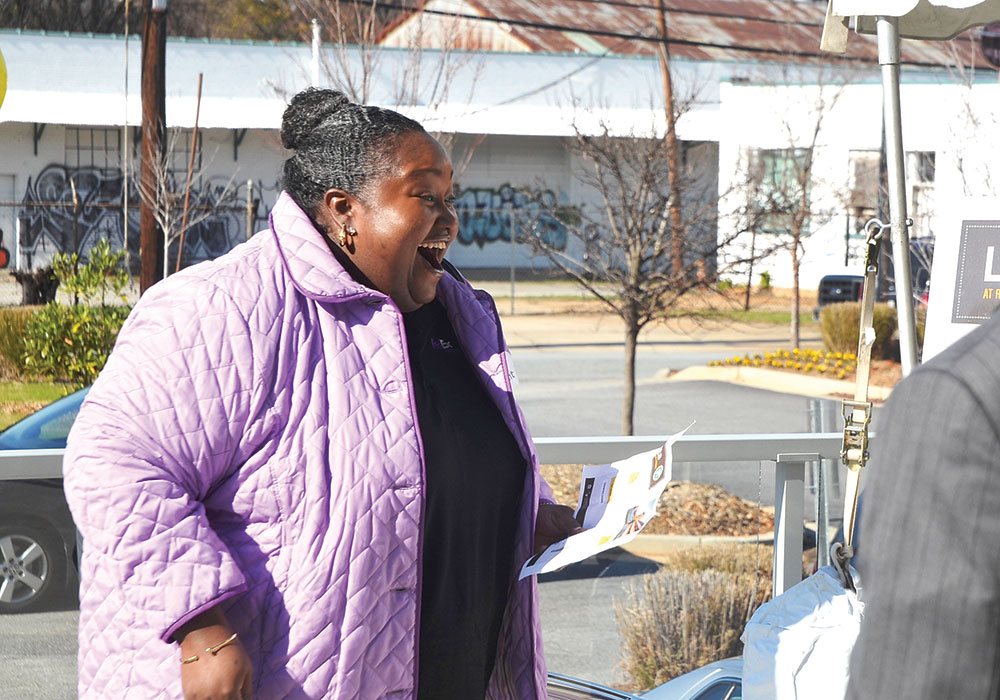
An Atlanta resident reacts when she wins an affordable housing drawing at the Lofts at Reynoldstown Crossing along the Atlanta BeltLine in 2011. An affordable housing trust fund has dedicated $12.5 million so far to areas near the trail network, but gentrification and rising prices persist. Photo courtesy Atlanta BeltLine, Inc.
ASSETS/AMENITIES
One of the common concerns stemming from gentrification is that newcomers will move into longtime neighborhoods and alter the existing character. Newcomers, they argue, won't respect the assets and amenities of the existing community and instead seek to create new ones.
In Chicago, the Local Initiatives Support Corporation pioneered the notion of comprehensive community development through its New Communities Program, which ran between 2003 and 2013. One of the key components of comprehensive community development was the quality-of-life plans prepared with community leaders and residents.
The planning process built the capacity of neighborhood leaders and their organizations to successfully lead neighborhood revitalization, and demonstrates how the combination of human, institutional, and physical assets inherent to each neighborhood can become the building blocks for equitable revitalization.
LISC-Chicago created 24 quality-of-life plans in Chicago during its 10-year run, which led to nearly 850 improvement projects totaling more than $900 million in new investments — perfectly aligned with the vision of the community.
Projects ranged from brick-and-mortar real estate development like new affordable residential units, residential rehab, and commercial development, to programs that support workforce development, social services, and public spaces and the arts.
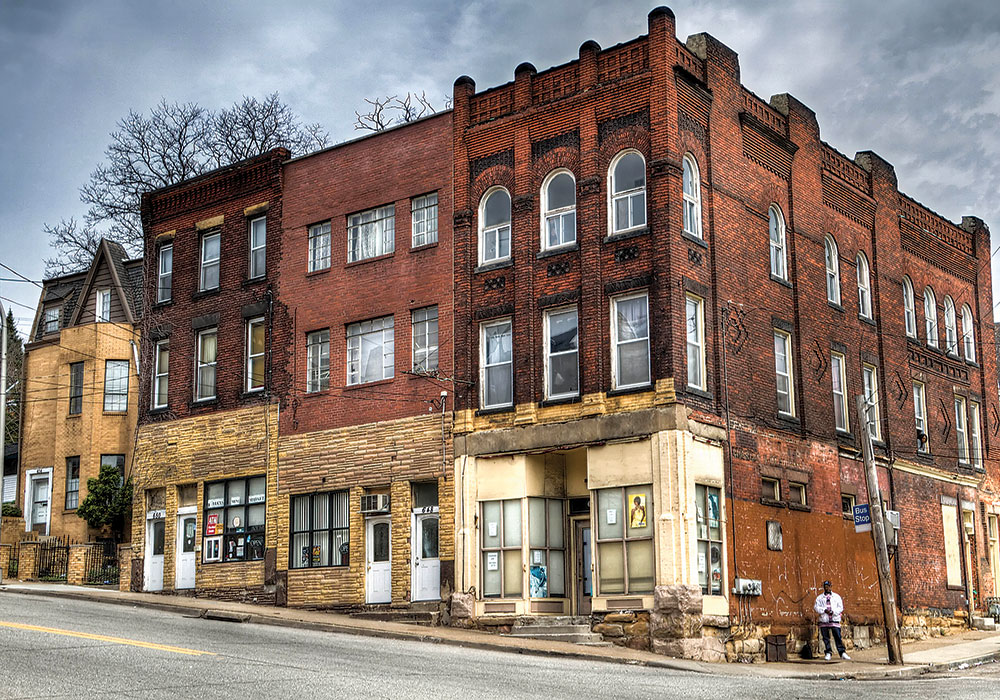
Pittsburgh's Hill District seeks to protect a historic hotbed of culture and art for the African American community. Photo by Ronald Woan.
LISC has limited its work in this area since downscaling the effort five years ago, but the model — sustained engagement with local stakeholders to identify assets and utilize them as the building blocks for revitalization — lives on.
Woo Kim, AICP, of the planning and design firm WRT, employed a similar planning process in Pittsburgh's Hill District beginning in 2016. Funded by a $500,000 Choice Neighborhoods Planning Grant from the U.S. Department of Housing and Urban Development, Kim's firm is leading the effort to use local assets as the foundation for revitalization.
"There is a real fear and anxiety that community revitalization could lead to gentrification," says Kim. "There's a real desire to preserve the culture of the community; [playwright] August Wilson grew up here and wrote about this neighborhood, and it's been a hotbed of culture and art for Pittsburgh's African-American community for decades. But we've found that when a stakeholder-driven process is in place there is community ownership of local projects."
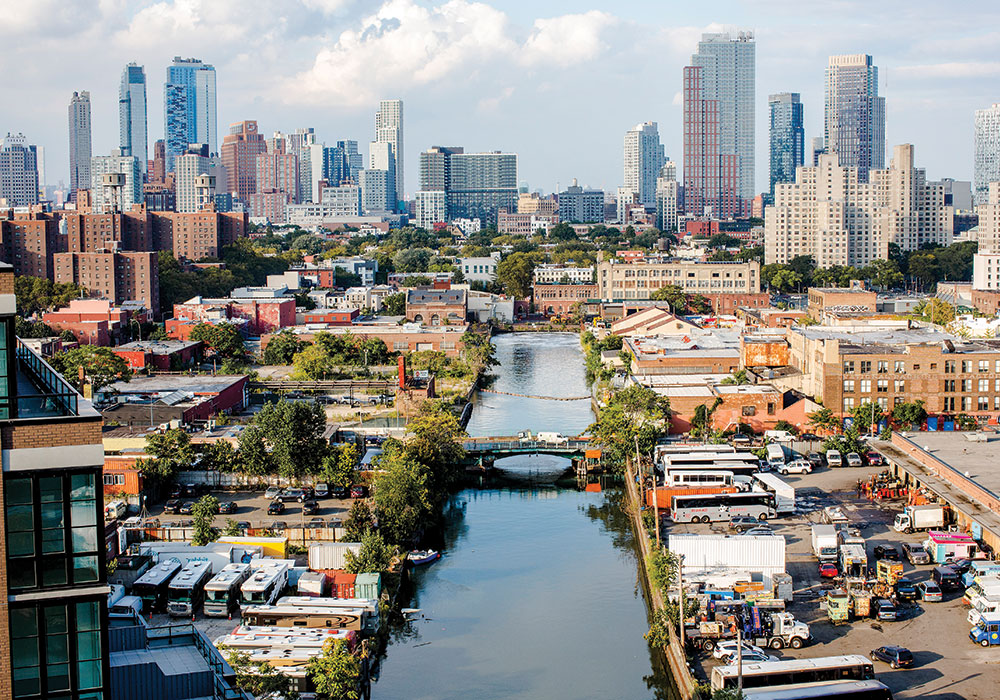
The legendarily polluted Gowanus Canal in Brooklyn, New York, seen from the roof of a new waterfront high rise. Affordable housing is a priority in the recently trendy neighborhood. Photo by Stephen Speranza, The New York Times.
HOUSING
In Brooklyn's Gowanus neighborhood, local housing activists pushed New York's Department of City Planning to more directly tackle issues of affordable housing in rapidly gentrifying areas. A Gowanus framework study was completed in June of this year to address those concerns. It is designed to provide guidance for a future rezoning in the neighborhood that will 1) prioritize buildings and infrastructure that will be prepared for rising sea levels and floods; 2) create more green space in the neighborhood; and 3) include the preservation of public housing units in neighborhoods and require new residential development to include an affordable housing component.
ENGAGEMENT
In many cities, a longtime legacy of neighborhood avoidance and stigmatization in some areas has promoted a sense of succession of neighborhoods, rather than integration.
This means many opportunities are lost for the engagement, networking, and sharing of community values and traditions that makes community living great. The Folded Map Project in Chicago is an example of engagement laying the groundwork for revitalization without gentrification.
The Folded Map Project is a photography exhibit and community initiative by photographer Tonika Johnson, who uses the physical structure of the city to encourage such engagement.
Johnson, who grew up in Chicago's Englewood community, realized that the city's grid and address system led to "mirror image" addresses on the North and South sides of the city — the 6500 block of North Hermitage Street, for example, could be paired with a corresponding 6500 block of South Hermitage Street.
The social, cultural, and economic differences for each, however, could be vast. Johnson's idea was to seek out persons at the mirror addresses and have them interact at each location.
Johnson has since brought many such "map twins" together during an exhibit at the Loyola University Museum of Art.
The interactions are an opportunity to share the contrasts and similarities that exist in the city, and opens the door for viewing residents of Far-flung neighborhoods as very real people. They are not abstract.
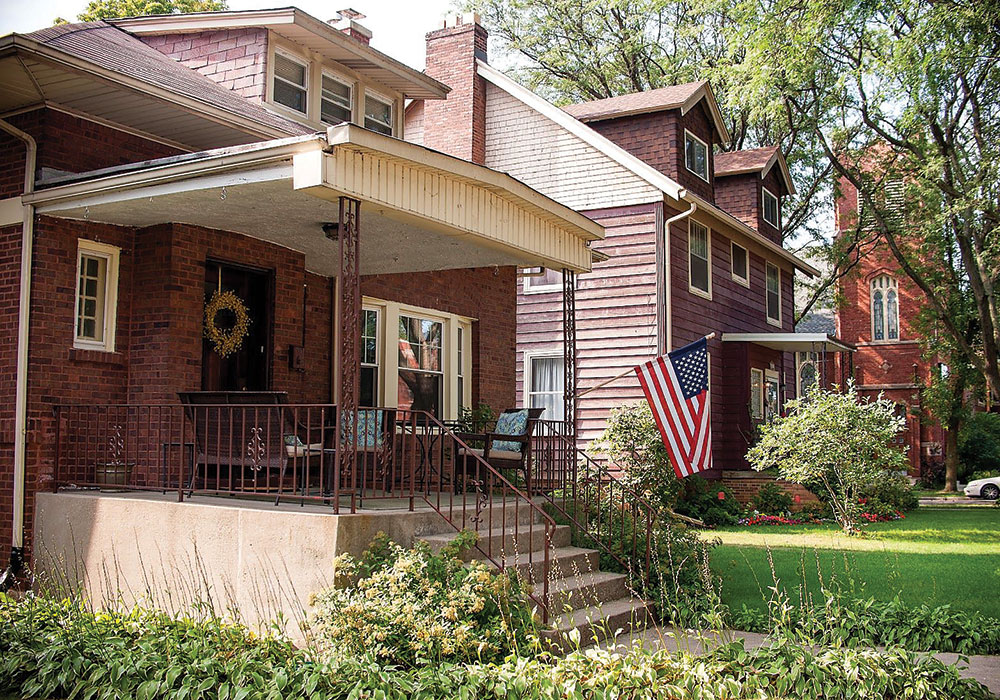
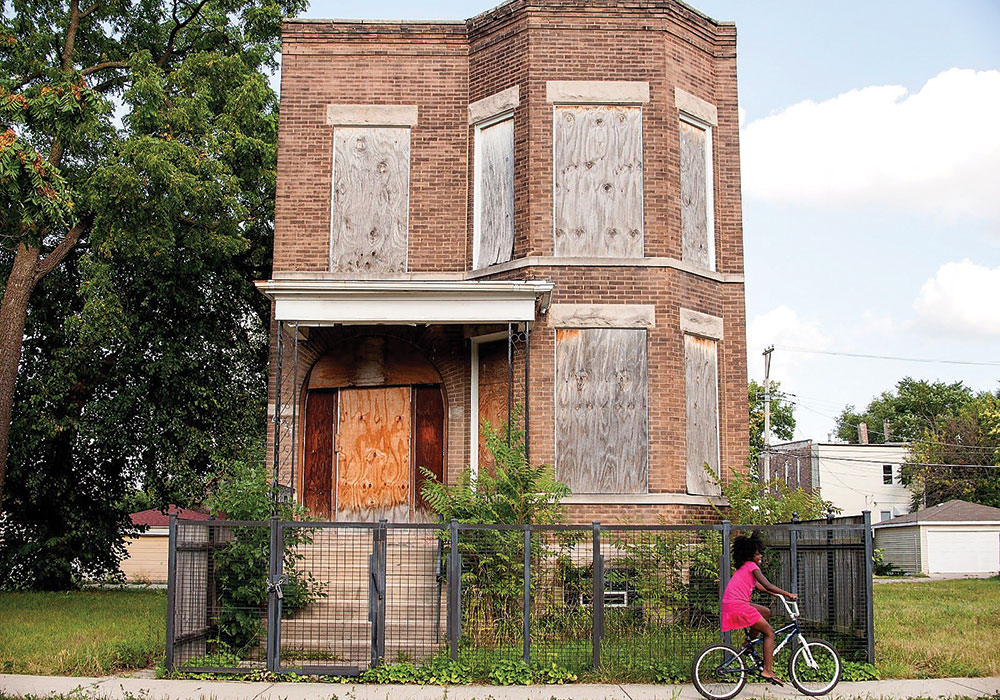
Photographer Tonika Johnson's Folded Map exhibition paired addresses on the same street on the North (top) and South sides of Chicago and brought their residents together to meet each other. Photos by Tonika Johnson.
Finding a balance
As a kid growing up in Detroit in the 1970s and '80s, I saw neighborhoods all around me that were in need of revitalization.
Many of those neighborhoods are in the same condition today. Sadly, the winds of economic and social change were not blowing in the direction of the Motor City then.
Fast-forward to today, and neighborhoods are experiencing a rebound that was inconceivable a generation ago, even in Detroit. But in many cities the pendulum has wildly swung in the opposite direction, causing more disruption.
Planners now have the opportunity, if not the imperative, to find the right balance of revitalization and equity.
Pete Saunders is a freelance writer who has published widely on urbanism topics. His home base is his blog, The Corner Side Yard.
Resources
Chicago's Neighborhood Improvement Program now offers loans to help residents make repairs and stay in their homes. bit.ly/2CHFkrG
Data Driven Detroit's Neighborhood Dynamics Index identifies areas where potential investments will have a high impact. bit.ly/2O8OqzO
Philadelphia's social impact scoring element encourages developers to seek out social impact components in their proposals. A new building at 8th and Vine will be home to the Equal Justice Center and about 20 public service legal aid agencies and social services organizations. The EJC will service more than 40,000 low-income residents each year and will have a $202 million economic impact on the neighborhood. bit.ly/2JgVcT7
Photographer Tonika Johnson's Folded Map exhibition paired addresses on the same street on the North and South sides of Chicago and brought their residents together to meet each other. tonijphotography.com


